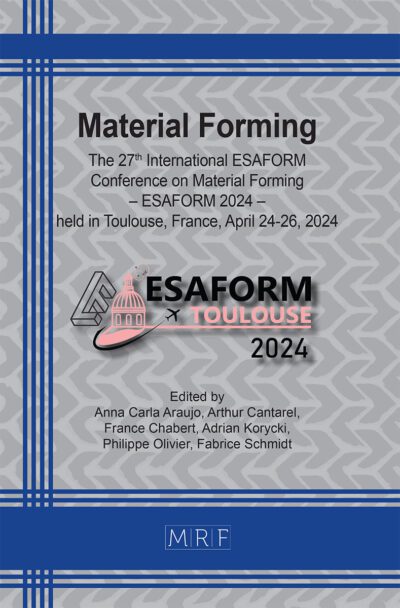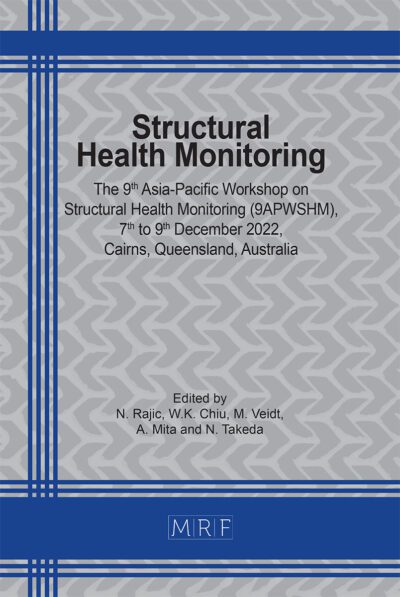Towards the 3D printing of inducible materials
Martín Pérez Sánchez, Manuel Ibañez, Luis Domenech Ballester
Abstract. Induction welding in additive manufacturing presents a novel solution to overcome the volume limitations of Fused Deposition Modeling (FDM) 3D printing by joining printed parts using heat generated from electromagnetic fields. This study investigates the influence of printing parameters, material composition, and induction conditions on the heat generation of thermoplastic composites embedded with metallic fibers. Using a Fused Granulate Fabrication (FGF) printer, Acrylonitrile Butadiene Styrene (ABS) with 10% stainless steel fibers was extruded, and X-ray imaging was employed to evaluate the distribution and orientation of the fibers within the material. Induction experiments demonstrated that the uniformity of fiber distribution, fiber orientation, and layer orientation has an impact on the maximum temperature achieved during induction. Only the transverse orientation rotated 90° exceeding the typical extrusion temperature for ABS in 3D printing. Making it the most effective configuration for induction welding. The findings highlight the importance of optimizing printing and induction parameters to enhance the performance and applicability of 3D-printed inducible for welding materials.
Keywords
Induction, 3D Printing, Composite Materials, Welding, Material Extrusion
Published online 5/7/2025, 8 pages
Copyright © 2025 by the author(s)
Published under license by Materials Research Forum LLC., Millersville PA, USA
Citation: Martín Pérez Sánchez, Manuel Ibañez, Luis Domenech Ballester, Towards the 3D printing of inducible materials, Materials Research Proceedings, Vol. 54, pp 106-113, 2025
DOI: https://doi.org/10.21741/9781644903599-12
The article was published as article 12 of the book Material Forming
![]() Content from this work may be used under the terms of the Creative Commons Attribution 3.0 license. Any further distribution of this work must maintain attribution to the author(s) and the title of the work, journal citation and DOI.
Content from this work may be used under the terms of the Creative Commons Attribution 3.0 license. Any further distribution of this work must maintain attribution to the author(s) and the title of the work, journal citation and DOI.
References
[1] O. Lucia, P. Maussion, E. J. Dede, and J. M. Burdio, “Induction heating technology and its applications: Past developments, current technology, and future challenges,” IEEE Transactions on Industrial Electronics, vol. 61, no. 5, pp. 2509–2520, 2014 https://doi.org/10.1109/TIE.2013.2281162. [2] Ketul M Patel, “AN OVERVIEW OF APPLICATIONS OF INDUCTION HEATING,” International Journal of Electrical Engineering & Technology (IJEET), Apr. 2019, [Online]. Available: http://iaeme.com/Home/journal/IJEET81editor@iaeme.com
[3] Z. Y. Liu, C. Li, X. Y. Fang, and Y. B. Guo, “Energy Consumption in Additive Manufacturing of Metal Parts,” Procedia Manuf, vol. 26, pp. 834–845, Jan. 2018. https://doi.org/10.1016/J.PROMFG.2018.07.104
[4] Rudnev Valery, Loveless Don, and L. Cook Raymond, Handbook of Induction Heating, 2nd Edition. CRC Press, 2017.
[5] P. S. Minh, H. D. S. Toan, and T. A. Son, “Metal 3D Printing by Fused Deposition Modeling (FDM) with Metal Powder Filament Materials,” Defect and Diffusion Forum, vol. 417, pp. 61–65, 2022. https://doi.org/10.4028/P-9S0SKZ
[6] M. Tebianian et al., “A Review of the Metal Additive Manufacturing Processes,” Materials 2023, Vol. 16, Page 7514, vol. 16, no. 24, p. 7514, Dec. 2023. https://doi.org/10.3390/MA16247514
[7] Ben Redwood, Filemon Schöffer, and Brian Garret, The 3d Printing Handbook. Technologies, design and aplications. 3D HUBS, 2020.
[8] A. Jandyal, I. Chaturvedi, I. Wazir, A. Raina, and M. I. Ul Haq, “3D printing – A review of processes, materials and applications in industry 4.0,” Sustainable Operations and Computers, vol. 3, pp. 33–42, Jan. 2022. https://doi.org/10.1016/j.susoc.2021.09.004
[9] B. Mallikarjuna, P. Bhargav, S. Hiremath, K. G. Jayachristiyan, and N. Jayanth, “A review on the melt extrusion-based fused deposition modeling (FDM): background, materials, process parameters and military applications,” 2023, Springer-Verlag Italia s.r.l. https://doi.org/10.1007/s12008-023-01354-0
[10] V. K. Tiwary, A. P, and V. R. Malik, “An overview on joining/welding as post-processing technique to circumvent the build volume limitation of an FDM-3D printer,” Rapid Prototyp J, vol. 27, no. 4, pp. 808–821, May 2021. https://doi.org/10.1108/RPJ-10-2020-0265/FULL/HTML
[11] “The Wohlers Report ,” 2021.
[12] C. Saraf, M. Dharmesh Barodiya, and D. Barodiya, “Post Processing Methods in Fused Deposition Modelling-A Review,” 2021. [Online]. Available: https://www.researchgate.net/publication/355096251
[13] S.-H. Ahn, M. Montero, D. Odell, S. Roundy, and P. K. Wright, “Anisotropic material properties of fused deposition modeling ABS”. https://doi.org/10.1108/13552540210441166
[14] G. K. Sharma, P. Pant, P. K. Jain, P. K. Kankar, and P. Tandon, “On the suitability of induction heating system for metal additive manufacturing,” vol. 235, no. 1–2, pp. 219–229, Jul. 2020. https://doi.org/10.1177/0954405420937854
[15] A. A. Oskolkov, D. N. Trushnikov, and I. I. Bezukladnikov, “Application of induction heating in the FDM/FFF 3D manufacturing,” in Journal of Physics: Conference Series, IOP Publishing Ltd, Feb. 2021. doi: 10.1088/1742-6596/1730/1/012005
[16] T. J. Ahmed, D. Stavrov, H. E. N. Bersee, and A. Beukers, “Induction welding of thermoplastic composites—an overview,” Compos Part A Appl Sci Manuf, vol. 37, no. 10, pp. 1638–1651, Oct. 2006. https://doi.org/10.1016/J.COMPOSITESA.2005.10.009
[17] V. K. Tiwary, A. P․, and V. R. Malik, “Investigations on microwave-assisted welding of MEX additive manufactured parts to overcome the bed size limitation,” Journal of Advanced Joining Processes, vol. 7, Jun. 2023. https://doi.org/10.1016/j.jajp.2023.100141
[18] D. Grewell and A. Benatar, “Welding of plastics: Fundamentals and new developments,” International Polymer Processing, vol. 22, no. 1, pp. 43–60, Mar. 2007. https://doi.org/10.3139/217.0051/HTML
[19] S. K. Bhudolia, G. Gohel, K. F. Leong, and A. Islam, “Advances in Ultrasonic Welding of Thermoplastic Composites: A Review,” Materials (Basel), vol. 13, no. 6, Mar. 2020. https://doi.org/10.3390/MA13061284
[20] J. J. Fallon, S. H. McKnight, and M. J. Bortner, “Highly loaded fiber filled polymers for material extrusion: A review of current understanding,” Addit Manuf, vol. 30, p. 100810, Dec. 2019. https://doi.org/10.1016/J.ADDMA.2019.100810
[21] S. Wickramasinghe, T. Do, and P. Tran, “FDM-Based 3D Printing of Polymer and Associated Composite: A Review on Mechanical Properties, Defects and Treatments,” Polymers 2020, Vol. 12, Page 1529, vol. 12, no. 7, p. 1529, Jul. 2020. https://doi.org/10.3390/POLYM12071529
[22] X. Xu, H. Ren, S. Chen, X. Luo, F. Zhao, and Y. Xiong, “Review on melt flow simulations for thermoplastics and their fiber reinforced composites in fused deposition modeling,” J Manuf Process, vol. 92, pp. 272–286, Apr. 2023. https://doi.org/10.1016/J.JMAPRO.2023.02.039
[23] P. Roudný and T. Syrový, “Thermal conductive composites for FDM 3D printing: A review, opportunities and obstacles, future directions,” J Manuf Process, vol. 83, pp. 667–677, Nov. 2022. https://doi.org/10.1016/J.JMAPRO.2022.09.026














